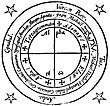
Back Renesanční magie Czech Renesanca magio Esperanto Magia renacentista Spanish Magia no Renascimento Portuguese Магические воззрения деятелей Возрождения Russian

| Part of a series on |
| Magic |
|---|
 |
Renaissance magic was a resurgence in Hermeticism and Neo-Platonic varieties of the magical arts which arose along with Renaissance humanism in the 15th and 16th centuries CE. During the Renaissance period, magic and occult practices underwent significant changes that reflected shifts in cultural, intellectual, and religious perspectives. C. S. Lewis, in his work on English literature, highlighted the transformation in how magic was perceived and portrayed. In medieval stories, magic had a fantastical and fairy-like quality, while in the Renaissance, it became more complex and tied to the idea of hidden knowledge that could be explored through books and rituals. This change is evident in the works of authors like Spenser, Marlowe, Chapman, and Shakespeare, who treated magic as a serious and potentially dangerous pursuit.[1]
Heinrich Cornelius Agrippa, a scholar, physician, and astrologer, popularized the Cabbalistic and Hermetic magic of Marsilio Ficino and Giovanni Pico della Mirandola. Agrippa's ideas on magic were revolutionary, and he faced persecution for his criticism of authorities and ruling classes. His work, De occulta philosophia, explored both benevolent and malevolent magic, but he rejected forbidden forms of sorcery. Similarly, Paracelsus, a Swiss physician and alchemist, combined medical practice with astrology. He introduced elemental beings and viewed the cosmos as interconnected, assigning spiritual significance to natural elements.
Nostradamus, a French astrologer and reputed scryer, gained fame for allegedly predicting future events through his prophecies. His works contained cryptic verses and calendars, attracting both admirers and skeptics. Johann Weyer, a Dutch physician and disciple of Agrippa, advocated against the persecution of witches and argued that accusations of witchcraft were often based on mental disturbances. John Dee, an English mathematician and occultist, explored alchemy, divination, and Hermetic philosophy. His collaboration with Edward Kelley resulted in a system of elaborate angelic communications and mystical teachings known as Enochian magic.
Collectively, these figures wove a complex fabric of Renaissance magic, a time marked by a blending of mystical and scientific ideas, as well as a redefinition of the perception of magic. This era saw magic evolve from a fanciful element in stories to a domain of spiritual exploration and hidden knowledge.
© MMXXIII Rich X Search. We shall prevail. All rights reserved. Rich X Search